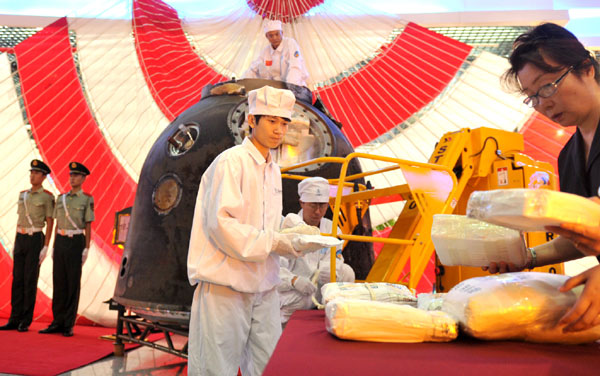Shenzhou mission sparks 'science fever'
Updated: 2012-07-02 01:56
By Wang Xiaodong (China Daily)
|
||||||||
The launch and safe return of the Shenzhou IX spacecraft has ignited an outbreak of "popular science fever" in China, which provides an excellent opportunity to boost science awareness, according to experts.
"After every major astronomical event, we see a rapid rise in the number of visitors, and this spacecraft launch is no exception," said Zhang Yang, director of popular science at Purple Mountain Observatory, which is affiliated to the Chinese Academy of Sciences.
 |
|
Workers remove crop seeds, microorganisms and other articles from the return capsule of the Shenzhou IX spacecraft on Sunday in Beijing. China Manned Space Agency and China Aerospace Science and Technology Corporation organized a ceremony to open the hatch of the capsule and take out the articles that traveled with the spacecraft during the 13-day mission to space. Su Dong / For China Daily |
The attention can also be seen in rising numbers of followers of its account on Sina Weibo, the popular Chinese micro-blogging website, he said.
"Before the launch of the spacecraft in mid-June, the popular science department had about 12,000 fans. Now the number is past 14,000."
Bookstores in some cities are reporting increased orders of popular science books, according to media reports.
To meet the growing demand for aerospace knowledge, Beijing-based China Space Museum holds a month-long exhibition in Hong Kong, starting June 28, Xinhua News Agency reported. Items on display will include authentic products used in the launch, including the national flag that traveled on the spacecraft, rocket models and items used by the astronauts in space, such as canned food, ice cream, sleeping bags and toilets.
"The launch of Shenzhou IX has provided an excellent opportunity to popularize scientific knowledge and enhance their attitude toward science," said Ge Ting, a researcher in popular sciences with the China Association for Science and Technology.
Tens of millions of people across China are believed to have watched the journey on TV, from launch to return, which proves the growing interest in science and technology, he said.
"However, people in general still lack enough scientific knowledge and awareness, and more effort is needed to address the problem," he added.
A national survey last year showed only 3.27 percent of residents on the mainland had basic scientific awareness and knowledge, a long way behind major developed countries such as Japan and Canada.
Wu Danhong, an associate professor at China University of Political Science and Law, warned a lack of basic scientific knowledge and judgment can lead to needless levels of panic in times of emergency.
One example, he said, was the first few days after the nuclear crisis in Japan in March 2011, when people in many Chinese cities hoarded salt due to rumors that the leakage had polluted the seas and made the salt produced from the seawater inedible. Many people were also convinced that iodized salt can protect against radiation poisoning.
"Great events provide us with excellent opportunities to spread scientific knowledge," Ge said, "but we must find new ways of teaching."
He suggested the media get more involved in finding new and exciting ways of reporting scientific stories and facts.
For example, he said, during the live TV broadcast of the return of Shenzhou IX, reporters could have added some explanation on how the astronauts could stay in the spacecraft safely without being burned by high temperatures caused by intense friction between the spacecraft and the air.
Contact the writer at wangxiaodong@chinadaily.com.cn

 Relief reaches isolated village
Relief reaches isolated village
 Rainfall poses new threats to quake-hit region
Rainfall poses new threats to quake-hit region
 Funerals begin for Boston bombing victims
Funerals begin for Boston bombing victims
 Quake takeaway from China's Air Force
Quake takeaway from China's Air Force
 Obama celebrates young inventors at science fair
Obama celebrates young inventors at science fair
 Earth Day marked around the world
Earth Day marked around the world
 Volunteer team helping students find sense of normalcy
Volunteer team helping students find sense of normalcy
 Ethnic groups quick to join rescue efforts
Ethnic groups quick to join rescue efforts
Most Viewed
Editor's Picks

|

|

|

|

|

|
Today's Top News
Health new priority for quake zone
Xi meets US top military officer
Japan's boats driven out of Diaoyu
China mulls online shopping legislation
Bird flu death toll rises to 22
Putin appoints new ambassador to China
Japanese ships blocked from Diaoyu Islands
Inspired by Guan, more Chinese pick up golf
US Weekly

|

|






